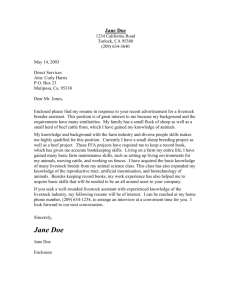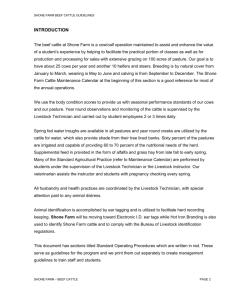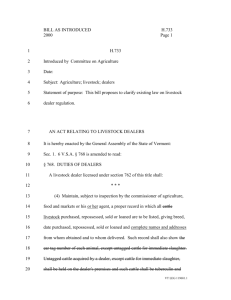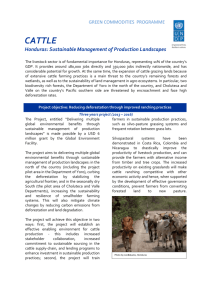Chapter 3 * Safety in Livestock Production
advertisement
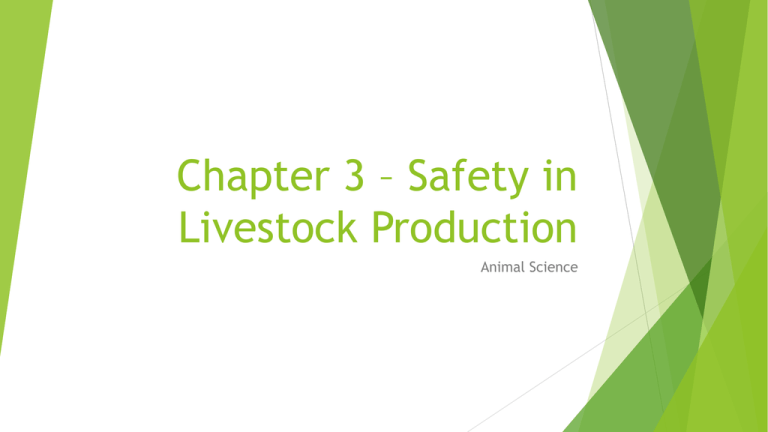
Chapter 3 – Safety in Livestock Production Animal Science Why is it important to be safe when working with farm animals? For the protection of the animal and human workers Most To situations are or can be life or death be profitable Other Reasons???? What will we be focusing on? Types and Kinds of Injuries Human and Environmental Factors Chemical Safety First Aid Kits Heat and Humidity HAZARDS IN HANDLING LIVESTOCK HORSE SAFETY PPE FACILITIES Fire Safety Bio Security and Agroterrorism WHY SAFETY? 2ND most deadly job (21 workers for every 100,000 death rate) Livestock cause very few deaths but are the leading cause of injury Machinery, falls, tractors lead most areas More than 200 children die each year as a result of farm injury The annual cost of farm accidents is estimated at $4-$5 billion dollars Farmers who hire others to work for them on their farm must follow and abide OSHA standards OCCUPATIONAL SAFTEY AND HEALTH ACT TYPES AND KINDS OF INJURIES Most people hurt by cattle or hogs are males Equal numbers of males and females are hurt by horses Cattle and horse kicks are most often the cause of injury followed by falls from riding horses Most serious accidents occur with horses and bulls FEWER THAN 10% OF INJURIES ARE TO HIRED HELP OR VISITORS TO THE FARM HUMAN AND ENVIRONMENTAL FACTORS RELATING TO SAFTEY Human error is the most major factor in the cause of farm accidents Young people (under 25) and older people (over 64) are the largest range of individuals hurt People who are not trained properly People that fail to wear proper PPE Dangerous environments (manure pits, corrals, silos, etc) Not well ventilated confinement facilities No back up electrical power CHEMICAL SAFETY Complete each JIGSAW Sheet and REPORT your findings to the group Wear PPE Read the Label Keep the Label Handy Use Common Sense First Aid Kits Bandages Eyewash solution Adhesive tape Ipecac Cotton balls Charcoal Thermometer Evaporated Milk and Can Opener Safety pins Salt Tweezers Teaspoon Bandage scissors List of names and doctors Chemical ice packs Splints Heat and Humidity Factors Heat Exhaustion Heat Stroke Dizziness, nausea, feeling weakness, lowered body temperature, and cold, clammy feel to the skin Reduce body temperature as quick as possible HAZARDS IN HANDLING LIVESTOCK When animals are handled there is always a possibility for injury The best way to prevent harm to you or them is to be aware of hazards and have good facilities No small or confined areas for work and animal together A mangate or other means of quick escape are needed Catwalks should be a part of chutes and alleys – Guardrails should be provided for catwalks 18” above the ground Provide non-slip flooring where possible Hazards (Continued) No sharp corners or protrusions Lighting should be adequate Never approach a cow from the rear or side. Try to approach from the front while talking in a conversational tone. Always wear boots or steel toe shoes when working with livestock Cattle See the World Differently Cattle can see 300 degrees with a blind spot directly behind them Cattle have poor depth perception Cattle have 60 degrees of vertical vision as compared to 140 for humans A shadow on the ground may look to be a deep crevasse to them The Sight Zone Flight Zone The Animals Personal Space (comfort zone) May be 5 feet for tame cattle to 300 feet for wild cattle Increases when approached from the head Increases when cattle are excited The Flight Zone Cattle are Round House Kickers Curved Working Chutes Prevent the animal from seeing the chute or truck Cattle If like to follow each other animal views dead end it will balk Single file chutes should be 20 feet long Response to Movement or Strange Sights Styrofoam cup in chute will cause a entire herd to balk A jacket hung on the wrong post will cause balk Use solid chute sides where cattle cannot see through the fence Stand back from head gate Planning Your Facilities Accommodates your working cattle and safe to humans Accessible to people, trucks and trailers Electricity and water Factors to Consider Accessibility Proximity in various weather conditions to pastures Conditions of pasture fence Drainage Electricity Proximity and lighting to neighbors A Well Designed Facility Holding Alley pens from pens to working area Crowding Working pen/tub alley Restraining Loading area/squeeze chute area Basic Corral Design Common Design Flaws Pens to Large Inadequate Poor Not number of pens for sorting placement of gates enough gates Confusing animal flow Livestock Facility Tips All working facilities should be planned and well organized. Lighting should be even and constant. No harsh contrasts of light. Eliminate Noise shadows reduction. Rubber stops and sliding gates. Livestock Facility Tips Design chutes either working or loading to be single file. Keep floor level or texture consistent. Reduce all foreign or moving objects from the working area. Create shields or blinds for workers to stand behind. Livestock Facility Tips Locate drains and metal grates outside working area. Working alleys need to have solid sides. The animal should see only one way out. Cut gates should be see through. Concrete surfaces should be deeply grooved and level to prevent slippage. Livestock Wisdom Animals have very little patience you should have more. Stress is a major contributor to economic losses. All animals are potentially dangerous. For every livestock death there are 400 disabling injuries. Horse Safety Information Sheet HAZARDS OF ANIMAL DISEASES Zoonoses – diseases and parasites transmitted between man and animal Rabies Brucellosis Bovine TB Trichinosis Salmonella Lepto Ringworm Tapeworm To Avoid: Clean Vaccinate Quarantine Sick Animals Avoid Exposure Wear Rubber Gloves PPE – Personal Protective Equipment Respirators for poor ventilated areas, dusty, or moldy hay, silos, manure storage areas, and with the use of pest-control chemicals Goggles/Safety Glasses with impact lenses for dust and chemicals Gloves (Cloth or Leather) Livestock workers are exposed to 3 kinds of atmosphere contamination: - Dust and particulate from feed - animal hair - Fecal matter PPE Additional concerns are given for pesticides, gases from manure pits (ammonia, hydrogen sulfide, methane, & carbon dioxide) 2 types of respiratory equipment - Air purifying respirators use filters (one removes particles and one removes vapor and gas) - Atmosphere-supplying respirators supply air from a source - Only respirators that meet NIOSH standards should be used. FACILITIES What are some facility dangers you can think of? Silo Hazards (falls and gases) Grain Handling and Storage Hazards (unloading grain, suffocation, dust and molds, etc.) Livestock Confinement Buildings (gases, power failures, fire, explosions) http://www.youtube.com/watch?v=oAsBscxpKks Fire Safety Electrical, heaters, carelessness, lightning, arson, and spontaneous combustion 70% of farm fires are caused by electrical issues To protect you and/or your farm: - Protect buildings from lightning - Store fuels properly - Clean regularly - Don’t allow those to smoke around high fire hazard areas - http://www.youtube.com/watch?v=e5xlpS0KrPY BioSecurity and Agroterrisom Biosecurity – protection from biological harm or living things from diseases, pests, and bioterrorism Bioterrorism- the deliberate use of biological or chemical weapons Agroterrorism – the deliberate use biological or chemical weapons to bring harm to agricultural enterprises Agrosecurity – the use of all possible means and procdures to guard against deliberate or incidental harm to the food production supply.
